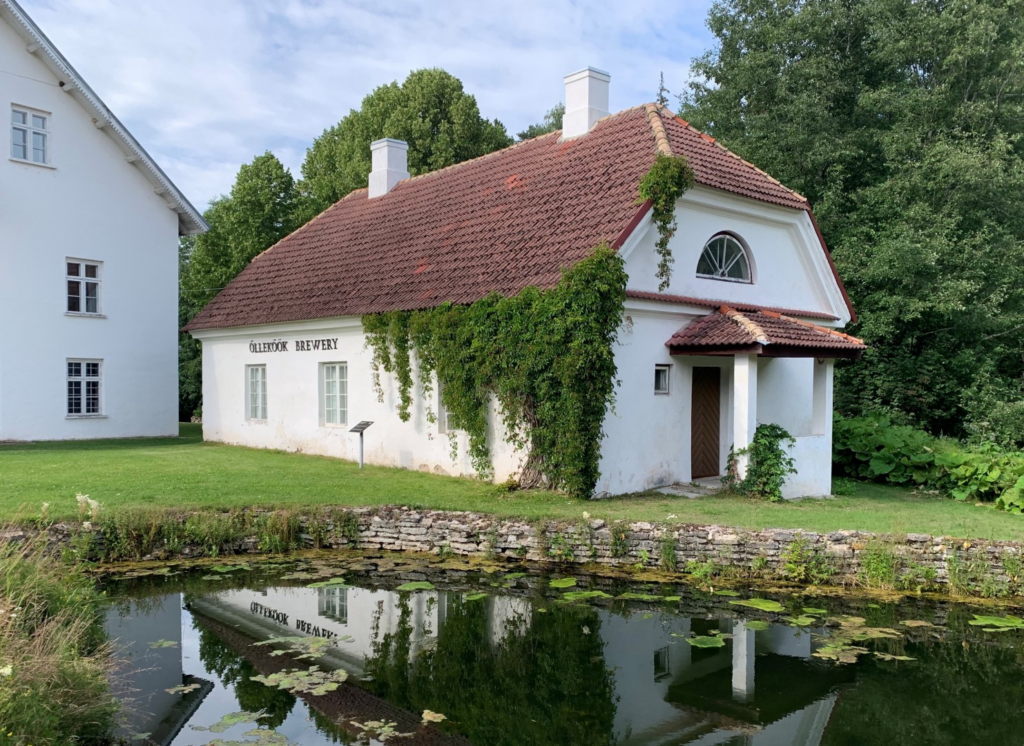Beer Kitchen

The wooden brewery existed in its current place in the 18th century, probably earlier.
The current stone building was completed in the 1820s.
As large breweries equipped with machines had started operating in Estonia in the second half of the 19th century, the beer kitchen was converted into accommodation for the manor servants at the end of the 19th century.
Martin Luther (1483-1586)
RED MORE
Anyone who drinks beer goes to bed early.
Anyone who sleeps longer sins less, anyone who sins less can enter Paradise.
Beer components
READ MORE
Beer is a beverage whose main components are water, malt, hops and yeast.
Additional components are juniper berries, beanstalks, St. John’s wort, honey, bath whisks made of birch trees grown in the bog, etc.
When growing grain for the necessary malt, it was observed that it had grown well when it had a beautiful straw-yellow colour and shine.
The most common source material was, of course, barley; other grains, such as wheat, rye and oat, were used much less frequently.
However, mixed beer was made, where the most common ratio is two parts barley and one part wheat or rye.
Brewing process
READ MORE
Malt – Grinding – Mashing – Boiling the wort – Cooling – Fermentation – Fermentate – Lagering – Bottling – DRINKING!
Manor beer varieties
READ MORE
In the 18th century, four types of beer were produced in the manor: tavern beer, ice cellar beer, table beer and bottled beer.
Beer was brewed all year round as needed, both for the manor family and for sale.
Each manor house had its own brew master.
TAVERN BEER – ordinary peasant beer sold in manor taverns
TABLE BEER – less bitter and leaner, for daily use in the manor
ICE CELLAR BEER – bitter and strong, brewed in March and consumed in summer, kept in an ice cellar so that it does not sour (also known as Märzen)
BOTTLED BEER – the strongest and most expensive, for sale in cities and German chambers of larger taverns
PALMSE MANOR SOLD BEER
in Viitna tavern, Kõrve tavern, Rahkma tavern, Võsu tavern.
Annual cycle of beer brewing and drinking
READ MORE
Beer was usually brewed three times a year in farms:
for christmas, midsummer’s day, Michaelmas day.
– christmas
Christmas beer is ready for the Winter Solstice (December 21).
On Candlemas (February 2), families visited each other and drank the last Christmas beer.
The host put a vetch in the last tankard, then it was clear that the beer was all gone.
– on summer holidaus (Pentecost in the church calendar), beer was made by those who could.
– on midsummer’s day, beer was also offered as a sacrifice to the fire.
– Beer was made for Michaelmas day and a ram was killed, they drank beer at each other’s houses.
– Beer was made on ST. Martin’s day and the servants were given a day off.
Beer was also brewed for weddings, funerals and christenings.
How to evaluate beer
READ MORE
Appearance 6%
Smell 24%
Taste 40%
Aftertaste 10%
Overall impression 20%
GROWLERS
Barrels – 120 pints
Half-barrel – 60 pints
Anchor – 14-15 pints
1 pint – 1.1864 litres
History of beer through great men
READ MORE
Hammurapi (1728-1686 BC) imposed strict requirements on the quality of beer varieties and strict penalties for violating them:
– a publican who charges for beer not in barley but in silver, or who sells beer for higher value, must be drowned
– a female priest who sets foot in an inn or opens a tavern herself must be burned alive
– beer diluters are drowned in a barrel or beer is poured into them until they suffocate
JULIUS CAESAR (100-44 BC) considered beer a nutritious and empowering drink and made sure that his army was adequately supplied with beer at all times.
Caesar had beer served to his guests in golden beakers.
Emperor KARL THE GREAT (747-814) laid down a number of rules for brewing beer and ensured that people in his service, especially monks living in state monasteries, were provided with beer.
THE DUKE WILHELM IV OF BAVARIA (1493-1550) introduced the Beer Purity Act in 1516 – the Reinheitsgebot – which was the first known piece of legislation regulating food quality and is still in force today.
According to this, beer was a drink made from water, barley malt and hops
Beer values
READ MORE
9 reasons why people love beer:
1.Beer tastes good
2.Beer makes you feel better
3.Beer is refreshing
4.Beer is beautiful
5.The number of beers is unlimited
6.Beer forces people to communicate
7.Beer has historic value
8.Beer has cultural value
9.Beer makes you creative
Witchcraft, divination and other procedures
READ MORE
– In order to make the beer stronger and go to your head better, the brewer brought an old piece of a cartwheel while cooking hops, one that had rolled a lot in the world.
He twisted it around his head a couple of times, so that the beer could start to turn as the wheel did.
Then he put the wheel on the fire that boiled the hops.
Similarly, brewed beer had to go to the head well.
– In the old days, people said that barley must be cut with a sickle in the autumn, otherwise you won’t get a beer at Christmas.
– If the beer didn’t begin to ferment, an old sow was brought from the barn.
One held the sow’s ear, the other smacked it from behind.
Thus, the pig was moved three times clockwise around the brewery and pig hair was used to smoke the lower edge of the vat until the beer began to ferment.
– In order not to curse the beer, it was wiser to brew it at night.
– If there were rings on the beer while fermenting on St. Thomas’ Day, a wedding would take place in the family next year.
If there was a cross, then death.
When beer started fermenting on St. Thomas’ Day, good luck came next year.
If it didn’t start to ferment, there was no luck.
9000-year-long love story
READ MORE
Alcohol is not just an uplifting drink.
Since the beginning of time, it has been the main driving force of human culture and has encouraged the development of art, language and religion.

